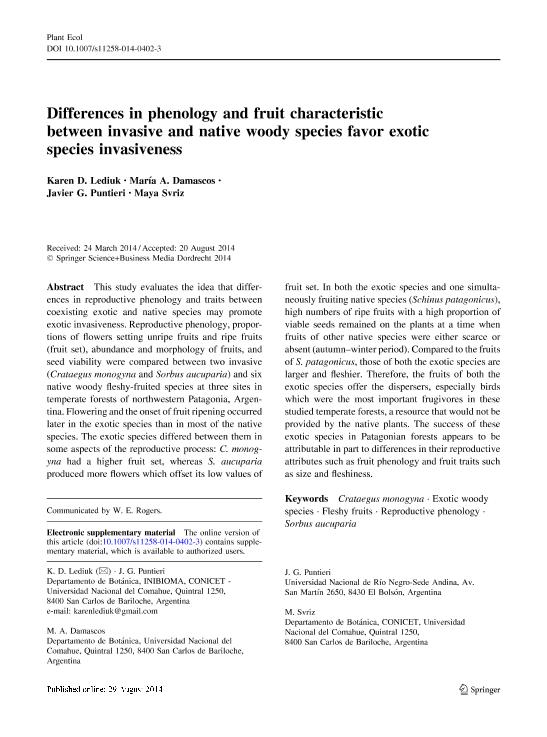Mostrar el registro sencillo del ítem
dc.contributor.author
Lediuk, Karen Daniela

dc.contributor.author
Damascos, Maria A.
dc.contributor.author
Puntieri, Javier Guido

dc.contributor.author
Svriz, Maya

dc.date.available
2017-01-27T21:03:13Z
dc.date.issued
2014-12
dc.identifier.citation
Lediuk, Karen Daniela; Damascos, Maria A.; Puntieri, Javier Guido; Svriz, Maya; Differences in phenology and fruit characteristic between invasive and native woody species favor exotic species invasiveness; Springer; Plant Ecology; 215; 12; 12-2014; 1455-1467
dc.identifier.issn
1385-0237
dc.identifier.uri
http://hdl.handle.net/11336/12132
dc.description.abstract
This study evaluates the idea that differences in reproductive phenology and traits between coexisting exotic and native species may promote exotic invasiveness. Reproductive phenology, proportions of flowers setting unripe fruits and ripe fruits (fruit set), abundance and morphology of fruits, and seed viability were compared between two invasive (Crataegus monogyna and Sorbus aucuparia) and six native woody fleshy-fruited species at three sites in temperate forests of northwestern Patagonia, Argentina. Flowering and the onset of fruit ripening occurred later in the exotic species than in most of the native species. The exotic species differed between them in some aspects of the reproductive process: C. monogyna had a higher fruit set, whereas S. aucuparia produced more flowers which offset its low values of fruit set. In both the exotic species and one simultaneously fruiting native species (Schinus patagonicus), high numbers of ripe fruits with a high proportion of viable seeds remained on the plants at a time when fruits of other native species were either scarce or absent (autumn–winter period). Compared to the fruits of S. patagonicus, those of both the exotic species are larger and fleshier. Therefore, the fruits of both the exotic species offer the dispersers, especially birds which were the most important frugivores in these studied temperate forests, a resource that would not be provided by the native plants. The success of these exotic species in Patagonian forests appears to be attributable in part to differences in their reproductive attributes such as fruit phenology and fruit traits such as size and fleshiness.
dc.format
application/pdf
dc.language.iso
eng
dc.publisher
Springer

dc.rights
info:eu-repo/semantics/openAccess
dc.rights.uri
https://creativecommons.org/licenses/by-nc-sa/2.5/ar/
dc.subject
Crataegus Monogyna
dc.subject
Exotic Woody Species
dc.subject
Fleshy Fruits
dc.subject
Reproductive Phenology
dc.subject
Sorbus Aucuparia
dc.subject.classification
Ciencias de las Plantas, Botánica

dc.subject.classification
Ciencias Biológicas

dc.subject.classification
CIENCIAS NATURALES Y EXACTAS

dc.title
Differences in phenology and fruit characteristic between invasive and native woody species favor exotic species invasiveness
dc.type
info:eu-repo/semantics/article
dc.type
info:ar-repo/semantics/artículo
dc.type
info:eu-repo/semantics/publishedVersion
dc.date.updated
2016-12-12T14:28:13Z
dc.identifier.eissn
1573-5052
dc.journal.volume
215
dc.journal.number
12
dc.journal.pagination
1455-1467
dc.journal.pais
Países Bajos

dc.journal.ciudad
Dordrecht
dc.description.fil
Fil: Lediuk, Karen Daniela. Consejo Nacional de Investigaciones Científicas y Técnicas. Centro Científico Tecnológico Patagonia Norte. Instituto de Investigación en Biodiversidad y Medioambiente; Argentina. Universidad Nacional del Comahue; Argentina
dc.description.fil
Fil: Damascos, Maria A.. Universidad Nacional del Comahue; Argentina
dc.description.fil
Fil: Puntieri, Javier Guido. Consejo Nacional de Investigaciones Científicas y Técnicas. Centro Científico Tecnológico Patagonia Norte. Instituto de Investigación en Biodiversidad y Medioambiente; Argentina. Universidad Nacional del Comahue; Argentina. Universidad Nacional de Rio Negro; Argentina
dc.description.fil
Fil: Svriz, Maya. Universidad Nacional del Comahue; Argentina. Consejo Nacional de Investigaciones Científicas y Técnicas; Argentina
dc.journal.title
Plant Ecology

dc.relation.alternativeid
info:eu-repo/semantics/altIdentifier/url/http://dx.doi.org/10.1007/s11258-014-0402-3
dc.relation.alternativeid
info:eu-repo/semantics/altIdentifier/url/http://link.springer.com/article/10.1007%2Fs11258-014-0402-3
Archivos asociados
